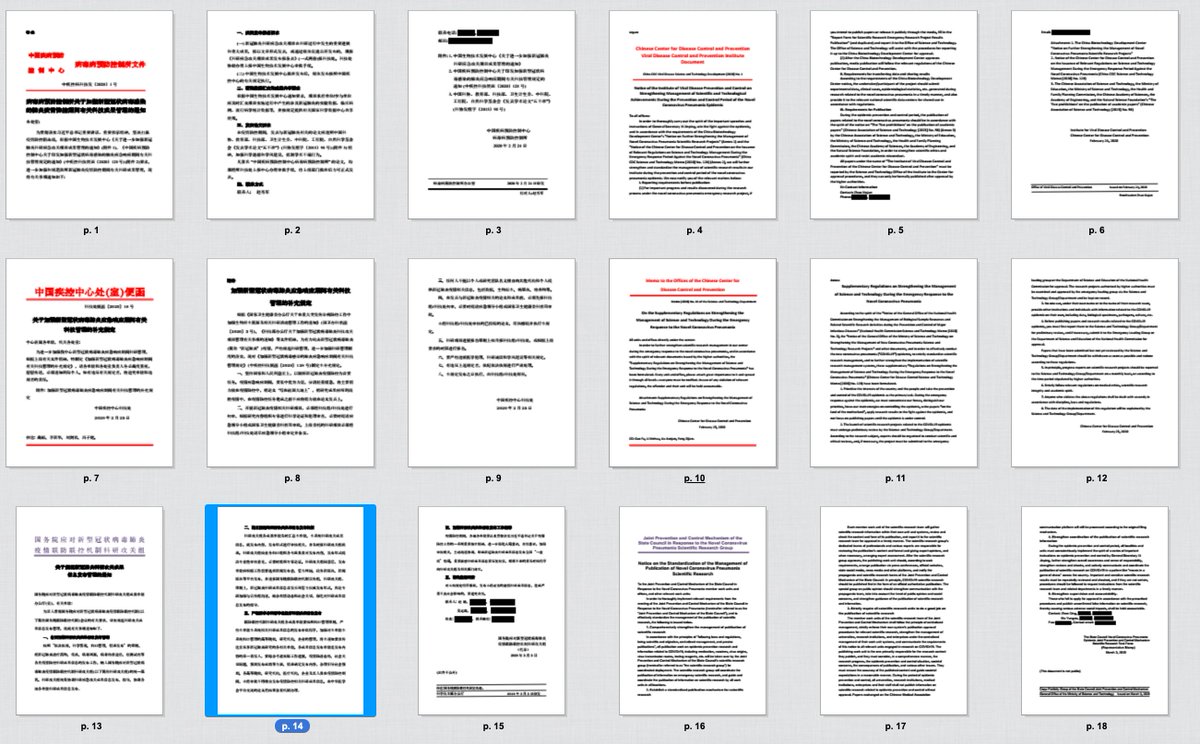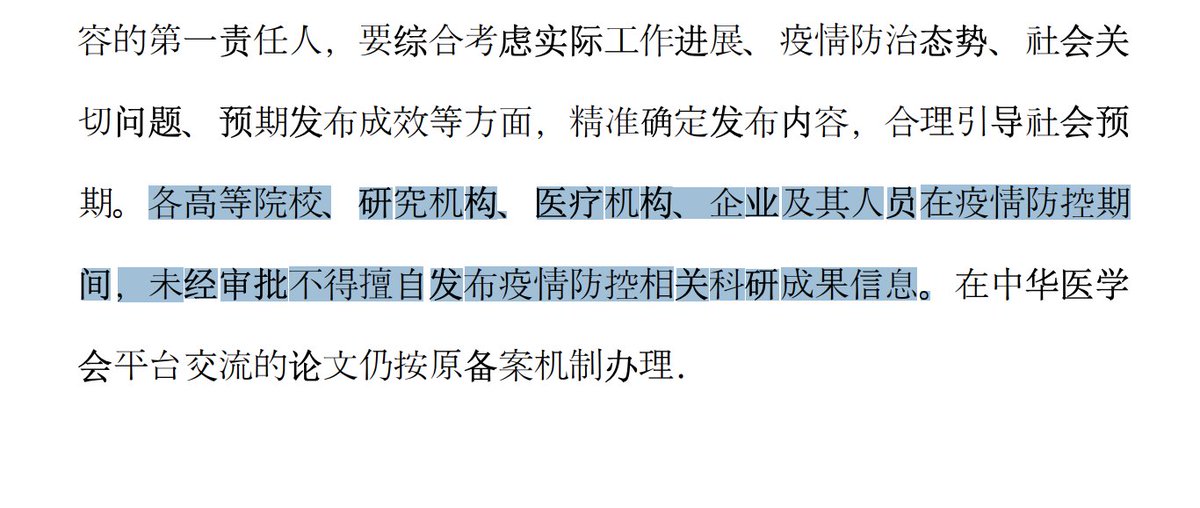
NEW: After Beijing announced the virus was spreading in Jan, Chinese scientists rushed to publish papers. Then, the tide slowed to a trickle.
Now, documents obtained by @AP show this happened b/c President Xi ordered new restrictions on COVID-19 research.
apnews.com/article/united…
Now, documents obtained by @AP show this happened b/c President Xi ordered new restrictions on COVID-19 research.
apnews.com/article/united…
2/The docs, retyped here without identifying marks, show authorities tightened research controls in Feb. and March - soon after a paper by Chinese scientists suggested the virus could have escaped from a Wuhan lab, kicking off an international blame game
web.archive.org/web/2020021414…

web.archive.org/web/2020021414…


3/Word of some restrictions trickled out on university websites earlier this year, where they were noticed, reported by @guardian @CNN, and promptly deleted. They showed professors needed approval to do research on the origins of the virus from authorities
nature.com/articles/d4158…
nature.com/articles/d4158…
4/What @AP has is far more sweeping. It's a ban on *all* universities, companies, research & medical institutions from sharing *any* COVID-19 data w/o permission.
That includes research on the origins, vaccines, and medication (which may explain odd gaps in Chinese vaccine data)
That includes research on the origins, vaccines, and medication (which may explain odd gaps in Chinese vaccine data)

5/@AP traced key orders to a visit by Xi to Tsinghua & the Academy of Military Medical Sciences on Mar. 2. There, Xi delivered an "important speech" on "coordinated" coronavirus research.
Left unsaid was what this "coordination" looked like in practice.
xinhuanet.com/politics/leade…


Left unsaid was what this "coordination" looked like in practice.
xinhuanet.com/politics/leade…



6/In practice, the gov't ordered all COVID-19 research in China to go through a review & approval process by a task force under the State Council, China's cabinet, before publication.
7/Some restrictions were intended as quality control. China's worries about substandard papers predates COVID-19. But the measures weren't driven just by scientific concerns.
They also involved propaganda and public opinion groups to "guide publication".
qstheory.cn/zhuanqu/bkjx/2…
They also involved propaganda and public opinion groups to "guide publication".
qstheory.cn/zhuanqu/bkjx/2…
7/Such input was needed to take into account "social concerns" to "guide societal expectation". In other words - research had to consider politics & public opinion, not just science.
Around then, leashes tightened on Chinese media. Magazine piece 发哨子的人 was swiftly censored
Around then, leashes tightened on Chinese media. Magazine piece 发哨子的人 was swiftly censored

8/Research on the origins of the virus, progressing at a rapid clip, suddenly seemed to stop.
Local media trumpeted one research team in Yunnan, saying they collected hundreds of samples in Feb. to look for the origins. They haven't been heard from since the new orders.

Local media trumpeted one research team in Yunnan, saying they collected hundreds of samples in Feb. to look for the origins. They haven't been heard from since the new orders.


9/Instead, there's now obstruction.
A team of scientists visiting a mineshaft which once hosted the closest relative of the COVID-19 virus was stopped by police and had their samples confiscated. My colleagues @stmcneil @HanGuanNg were tailed by cops, blocked by vans & SUVs.
A team of scientists visiting a mineshaft which once hosted the closest relative of the COVID-19 virus was stopped by police and had their samples confiscated. My colleagues @stmcneil @HanGuanNg were tailed by cops, blocked by vans & SUVs.

10/That doesn't mean research on the origins has stopped. Sources say the gov't tapped Chinese Academy of Sciences researcher Bi Yuhai to spearhead origins research - in part b/c of his close ties to Gao Fu, the head of the China CDC, who used to run Bi's lab. 

11/Posts we tracked down on the China CDC's website show that Bi is studying bat coronaviruses in collaboration with Russian scientists. But we have no idea what he's found so far.
Instead, he's published on another theory: that the virus can be spread via frozen seafood.

Instead, he's published on another theory: that the virus can be spread via frozen seafood.


12/CDC sources say there's ample evidence, pointing to outbreaks at markets & ports across China - Beijing, Dalian, Qingdao.
But state media seized on this theory to promote the notion that the virus was imported from abroad into Wuhan.
Experts reject this near-universally.
But state media seized on this theory to promote the notion that the virus was imported from abroad into Wuhan.
Experts reject this near-universally.

13/Scientists puzzle over odd gaps in data, such as on Wuhan's Huanan Market. For months, authorities said they suspected the outbreak started there - till China CDC suddenly said no animal samples tested positive, befuddling experts who didn't even know they were collected 

14/Also puzzling: gaps in testing old patient samples, which narrow the hunt for patient zero. China collected 330,000 flu surveillance samples last year which could easily be tested for COVID-19 - but so far data has been published on just 520 samples. 

15/ The little that's come out suggests the virus was already spreading outside Wuhan in late 2019, raising potentially awkward questions for Beijing. One child fell ill Jan 2. 120km from Wuhan, but the study didn't look earlier b/c it was politically sensitive, a scientist said 

16/Now, a year since we learned of COVID-19, a WHO team is preparing to go to China next month to learn more about its origins.
It's unclear what they'll find. Searches like this are complicated & take years, sometimes decades. But one thing is clear: info & access is tight
It's unclear what they'll find. Searches like this are complicated & take years, sometimes decades. But one thing is clear: info & access is tight

17/On Xi's orders, China has put into place mechanisms to bar or at least delay publication of COVID-19 research that could embarrass them.
It's hampering cooperation, sowing mistrust, & adding to one of the biggest mysteries of the 21st century: where the coronavirus came from.
It's hampering cooperation, sowing mistrust, & adding to one of the biggest mysteries of the 21st century: where the coronavirus came from.
and @nature! apologies for the omission
18/A pleasure to work on with my fearless, talented colleagues @stmcneil @mylcheng @HanGuanNg @emfwang & others from around the world.
• • •
Missing some Tweet in this thread? You can try to
force a refresh


